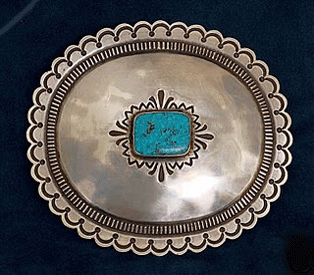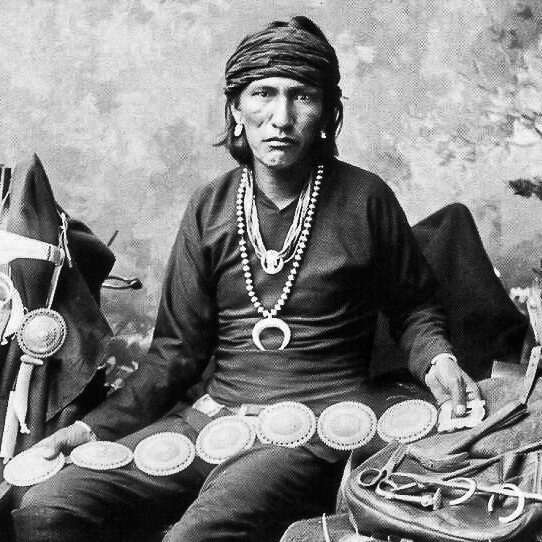
Echoes in Silver: The Enduring Legacy of Navajo Silversmithing
In the vast, sun-drenched landscapes of the American Southwest, where red rock mesas pierce an endless blue sky, a story of artistry, resilience, and cultural identity is etched not in stone, but in gleaming silver and vibrant turquoise. Navajo silversmithing, more than just a craft, is a living chronicle—a testament to innovation, adaptation, and an unwavering connection to heritage. From its nascent beginnings in the mid-19th century, born of cross-cultural exchange, to its present-day status as a globally recognized art form, the journey of Navajo silver is as intricate and profound as the pieces themselves.
The rhythmic tap-tap-tap of a hammer on metal, the hiss of a torch, the glint of polished silver—these are the sounds and sights that have defined generations of Navajo artisans. It’s a craft steeped in tradition, yet constantly evolving, much like the Diné (Navajo people) themselves.

The Genesis: Seeds of Innovation (Mid-19th Century)
Before the advent of silversmithing, the Diné adorned themselves with materials readily available from their environment and trade: shells, bones, wood, and later, brass and copper acquired from European settlers. The introduction of silver, however, marked a pivotal shift, transforming their material culture forever.
The craft arrived on the Navajo Nation not through direct European instruction, but through an intermediary: Mexican plateros (silversmiths). These artisans, inheritors of Spanish colonial metalworking traditions, taught their skills to their Pueblo neighbors, who in turn shared them with the Navajo. The timing was crucial: the mid-1800s saw increased interaction between the Navajo and surrounding cultures, and a growing availability of silver coinage, primarily Mexican pesos, which would become the raw material for early smiths.
The most widely credited figure in the genesis of Navajo silversmithing is Atsidi Sani (Old Smith), also known as Herrero (Blacksmith) by the Mexicans and Spaniards. Born around 1830, Atsidi Sani is believed to have learned the rudiments of smithing from a Mexican platero in the 1850s, possibly while trading or during the period of "The Long Walk" confinement at Bosque Redondo, though the exact circumstances remain debated. What is certain is that he quickly mastered the skill, applying his blacksmithing knowledge to the new medium of silver.
Early Navajo silverwork was utilitarian and relatively simple: bracelets, rings, and buttons made from hammered silver coins. These pieces were primarily for personal adornment, status, and trade. Tools were rudimentary—improvised from found objects: old files for shaping, stones for polishing, and bellows for fires. Atsidi Sani didn’t just learn; he taught. His sons, brothers, and other members of his community became his first apprentices, laying the foundation for a craft that would spread like wildfire through the Navajo Nation, largely along family lines.
As historian and curator Louise Lincoln noted, "The Navajos didn’t just adopt the craft; they made it uniquely their own. They took the basic techniques and imbued them with their own aesthetic and spiritual understanding."
The Formative Years: Evolution and Expansion (Late 19th – Early 20th Century)
The late 19th and early 20th centuries witnessed a rapid evolution in Navajo silversmithing. As tools became more sophisticated—ranging from purchased anvils and hammers to commercially available dies and stamps—the designs grew more complex. The introduction of turquoise was the true game-changer. While silver provided the canvas, turquoise gave the art its soul.

Turquoise, revered by many Southwestern Native American tribes for its connection to the sky and water, and believed to possess protective and healing properties, had been used in adornment for centuries. Its integration into silverwork, starting around the 1880s, transformed Navajo jewelry from simple metalwork into the iconic, stone-studded pieces we recognize today. The vibrant blue-green hues against the polished silver created a striking contrast that captivated observers.
During this period, many of the classic Navajo designs emerged:
- Concho Belts: Derived from Spanish equestrian silverwork, the concha (shell or oval disc) evolved into a distinct Navajo art form, often stamped with intricate designs and sometimes set with turquoise.
- Squash Blossom Necklaces: While the name is widely used, the "blossoms" are thought to be derived from the Spanish colonial pomegranate motif, symbolizing fertility. The central "naja" pendant, a crescent shape, is an ancient symbol found across many cultures, possibly introduced to the Navajo via Spanish horse bridles.
- Bracelets, Rings, and Earrings: Became increasingly elaborate, featuring repoussé (raised designs), stamping, and the setting of multiple turquoise stones in cluster or individual settings.
The burgeoning American tourism industry and the expansion of the railroad into the Southwest played a crucial role in the commercialization of Navajo silver. Trading posts, established across the reservation, became vital hubs. Traders, often referred to as "Indian Traders," provided raw materials (silver ingots, sheet silver, turquoise stones) and tools to the smiths, in exchange for finished jewelry and other goods. They also acted as intermediaries, selling the jewelry to a burgeoning market of tourists, collectors, and retailers across the country.
The Fred Harvey Company, a hospitality giant operating along the Santa Fe Railroad, was particularly instrumental. They commissioned large quantities of Navajo and Pueblo jewelry, selling it in their hotels and gift shops, and effectively introduced Native American art to a national audience. While this brought economic opportunity, it also led to some homogenization of designs and, at times, pressure on artisans to produce quickly and cheaply. Yet, the core integrity of the craft largely endured.
Maturation and Mastery: The Golden Age (Mid-20th Century)
By the mid-20th century, Navajo silversmithing had reached a peak of technical mastery and artistic expression. Artisans refined techniques such as:
- Ingot work: Melting silver and pouring it into molds before hammering it into desired shapes.
- Overlay: A distinctive technique where two sheets of silver are used, the top one cut with a design and oxidized in the recessed areas, revealing the polished bottom layer. While often associated with the Hopi, Navajo smiths also incorporated variations.
- Sand Casting: Pouring molten silver into molds made from sand, often creating heavier, sculptural pieces.
This era saw an explosion of creativity. While many smiths remained anonymous, their individual styles and mastery were evident in the sheer quality and diversity of work. Navajo silver was no longer just a curiosity; it was recognized as a legitimate art form, appreciated for its beauty, craftsmanship, and cultural significance. Collectors began to seek out unique pieces, and museums started acquiring examples for their permanent collections.
"For the Navajo people, silver is more than just ornamentation," explained a Navajo elder in a documentary from the 1970s. "It holds our stories, our prayers, our connection to the land and our ancestors. Each piece carries a spirit." This sentiment underscores the profound cultural weight of the craft, far beyond its economic value. It was a means of self-expression, a symbol of identity, and a tangible link to tradition.
Challenges and Resilience: Modern Era (Late 20th – 21st Century)
The late 20th and early 21st centuries have presented both opportunities and challenges for Navajo silversmithing. The market has become globalized, and the craft faces competition from mass-produced, often machine-made, and sometimes non-Native "Native-style" jewelry. This influx of inauthentic products poses a significant threat to the livelihoods of genuine Native American artists and the integrity of the art form.
In response, the Indian Arts and Crafts Act of 1990 was enacted, making it illegal to market or sell products in a way that falsely suggests they are Native American-made when they are not. This act provides some protection for authentic artisans and helps consumers make informed purchasing decisions.
Despite these challenges, Navajo silversmithing continues to thrive, adapting while holding fast to its roots. Contemporary Navajo artists are pushing the boundaries of the craft, incorporating new materials, exploring abstract designs, and fusing traditional techniques with modern aesthetics. They use diverse stones, experiment with different finishes, and often sign their work, gaining individual recognition.
Many young Navajo artists are returning to the craft, drawn by a desire to connect with their heritage and carry on the legacy of their ancestors. They learn from elders, attend workshops, and some even pursue formal art education. "It’s a way for me to speak my language, the language of my hands," says Myra Begay, a third-generation Navajo silversmith in her late twenties. "I’m not just making jewelry; I’m continuing a conversation that began with Atsidi Sani. I’m building on their foundation, but also adding my own chapter."
Organizations and institutions, both within and outside the Navajo Nation, are working to preserve and promote the art form through educational programs, exhibitions, and direct marketing initiatives that connect artists directly with buyers.
Echoes in the Present
Today, Navajo silversmithing stands as a vibrant testament to cultural resilience and artistic genius. Each meticulously crafted piece—a gleaming bracelet, a intricately stamped concho, a stunning turquoise-studded necklace—is more than just an adornment. It is a piece of history, a symbol of identity, and a profound expression of the Diné spirit.
The echoes of Atsidi Sani’s hammer still resonate across the mesas, carried forward by generations of skilled hands. In a world increasingly dominated by the fleeting and the mass-produced, Navajo silver endures as a powerful reminder of the beauty, depth, and timeless value of true craftsmanship and cultural heritage. It is a legacy forged in fire and silver, destined to shine for generations to come.


